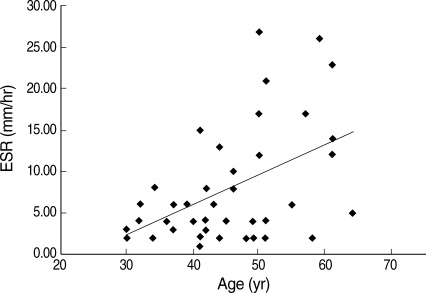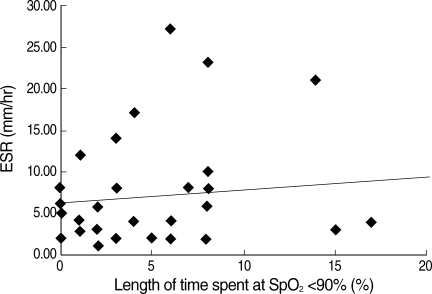Clin Exp Otorhinolaryngol.
2009 Sep;2(3):126-130.
A Relationship between the Obstructive Sleep Apnea Syndrome and the Erythrocyte Sedimentation Rate
- Affiliations
-
- 1Department of Otorhinolaryngology-Head and Neck Surgery, Samsung Medical Center, Sungkyunkwan University School of Medicine, Seoul, Korea. hysiam.kim@samsung.com
Abstract
OBJECTIVES
The erythrocyte sedimentation rate (ESR) is a marker for inflammation, and it has been identified as a risk factor for atherothrombotic cardiovascular disease. The aim of this study was to determine the relationship between the plasma ESR level and nocturnal oxygen desaturation or other polysomnographic variables and to examine the role of obesity in patients with obstructive sleep apnea syndrome (OSAS). METHODS: This retrospective study included 72 patients with a diagnosis of OSAS who underwent overnight polysomnography and routine blood tests between July and December of 2005. We compared the plasma ESR level with the sum of all the polysomnographic variables and divided the patient group into obese and non-obese patients. RESULTS: The mean ESR level was 8.45 mm/hr. There was a significant difference in the ESR level between genders (P<0.001). A significant correlation was found between the percentage of time spent at a SpO2 below 90% and the ESR level in the obese group (BMI > or =25, N=43, P=0.012). In addition, the ESR levels had a positive correlation with age in the obese group (P=0.002). However, there was no significant correlation with the percentage of time spent at a SpO2 below 90% in the whole group of patients and in the non-obese group (BMI <25, N=29). The ESR level showed no correlation with the other polysomnographic variables. CONCLUSION: The duration of deoxygenation in obese patients with OSAS may be associated with the ESR level which is an independent predictor of cardiovascular disease.
MeSH Terms
Figure
Reference
-
1. Grote L, Hedner J, Peter JH. Sleep-related breathing disorder is an independent risk factor for uncontrolled hypertension. J Hypertens. 2000; 6. 18(6):679–685. PMID: 10872551.
Article2. Kokturk O, Ciftci TU, Mollarecep E, Ciftci B. Elevated C-reactive protein levels and increased cardiovascular risk in patients with obstructive sleep apnea syndrome. Int Heart J. 2005; 9. 46(5):801–809. PMID: 16272771.3. Shahar E, Whitney CW, Redline S, Lee ET, Newman AB, Javier Nieto F, et al. Sleep-disordered breathing and cardiovascular disease: cross-sectional results of the Sleep Heart Health Study. Am J Respir Crit Care Med. 2001; 1. 163(1):19–25. PMID: 11208620.4. Vgontzas AN, Papanicolaou DA, Bixler EO, Kales A, Tyson K, Chrousos GP. Elevation of plasma cytokines in disorders of excessive day-time sleepiness: role of sleep disturbance and obesity. J Clin Endocrinol Metab. 1997; 5. 82(5):1313–1316. PMID: 9141509.
Article5. Visser M, Bouter LM, McQuillan GM, Wener MH, Harris TB. Elevated C-reactive protein levels in overweight and obese adults. JAMA. 1999; 12. 282(22):2131–2135. PMID: 10591334.
Article6. Shamsuzzaman AS, Gersh BJ, Somers VK. Obstructive sleep apnea: implications for cardiac and vascular disease. JAMA. 2003; 10. 290(14):1906–1914. PMID: 14532320.7. Natali A, L'Abbate A, Ferrannini E. Erythrocyte sedimentation rate, coronary atherosclerosis, and cardiac mortality. Eur Heart J. 2003; 4. 24(7):639–648. PMID: 12657222.
Article8. Lowe GD. Circulating inflammatory markers and risks of cardiovascular and non-cardiovascular disease. J Thromb Haemost. 2005; 8. 3(8):1618–1627. PMID: 16102027.
Article9. Yokoe T, Minoguchi K, Matsuo H, Oda N, Minoguchi H, Yoshino G, et al. Elevated levels of C-reactive protein and interleukin-6 in patients with obstructive sleep apnea syndrome are decreased by nasal continuous positive airway pressure. Circulation. 2003; 3. 107(8):1129–1134. PMID: 12615790.
Article10. Andresdottir MB, Sigfusson N, Sigvaldason H, Gudnason V. Erythrocyte sedimentation rate, an independent predictor of coronary heart disease in men and women: the Reykjavik Study. Am J Epidemiol. 2003; 11. 158(9):844–851. PMID: 14585762.
Article11. Timmer JR, Ottervanger JP, Hoorntje JC, De Boer MJ, Suryapranata H, van't Hof AW, et al. Prognostic value of erythrocyte sedimentation rate in ST segment elevation myocardial infarction: interaction with hyperglycaemia. J Intern Med. 2005; 5. 257(5):423–429. PMID: 15836658.
Article12. Silvestrini M, Rizzato B, Placidi F, Baruffaldi R, Bianconi A, Diomedi M. Carotid artery wall thickness in patients with obstructive sleep apnea syndrome. Stroke. 2002; 7. 33(7):1782–1785. PMID: 12105352.
Article13. Marin JM, Carrizo SJ, Vicente E, Agusti AG. Long-term cardiovascular outcomes in men with obstructive sleep apnoea-hypopnoea with or without treatment with continuous positive airway pressure: an observational study. Lancet. 2005; 3. 365(9464):1046–1053. PMID: 15781100.
Article14. Dziewas R, Humpert M, Hopmann B, Kloska SP, Ludemann P, Ritter M, et al. Increased prevalence of sleep apnea in patients with recurring ischemic stroke compared with first stroke victims. J Neurol. 2005; 11. 252(11):1394–1398. PMID: 16021359.
Article15. Good DC, Henkle JQ, Gelber D, Welsh J, Verhulst S. Sleep-disordered breathing and poor functional outcome after stroke. Stroke. 1996; 2. 27(2):252–259. PMID: 8571419.
Article16. Hermann DM, Bassetti CL. Sleep-disordered breathing and stroke. Curr Opin Neurol. 2003; 2. 16(1):87–90. PMID: 12544862.17. O'Leary DH, Polak JF, Kronmal RA, Kittner SJ, Bond MG, Wolfson SK Jr, et al. Distribution and correlates of sonographically detected carotid artery disease in the Cardiovascular Health Study: the CHS Collaborative Research Group. Stroke. 1992; 12. 23(12):1752–1760. PMID: 1448826.18. Wessendorf TE, Teschler H, Wang YM, Konietzko N, Thilmann AF. Sleep-disordered breathing among patients with first-ever stroke. J Neurol. 2000; 1. 247(1):41–47. PMID: 10701896.
Article19. Schulz R, Seeger W, Fegbeutel C, Husken H, Bodeker RH, Tillmanns H, et al. Changes in extracranial arteries in obstructive sleep apnoea. Eur Respir J. 2005; 1. 25(1):69–74. PMID: 15640325.
Article20. Festa A, D'Agostino R Jr, Howard G, Mykkänen L, Tracy RP, Haffner SM. Chronic subclinical inflammation as part of the insulin resistance syndrome: the Insulin Resistance Atherosclerosis Study (IRAS). Circulation. 2000; 7. 04. 102(1):42–47. PMID: 10880413.21. Haverkate F, Thompson SG, Pyke SD, Gallimore JR, Pepys MB. Production of C-reactive protein and risk of coronary events in stable and unstable angina: European Concerted Action on Thrombosis and Disabilities Angina Pectoris Study Group. Lancet. 1997; 2. 349(9050):462–466. PMID: 9040576.22. Carlson LA, Bottiger LE, Ahfeldt PE. Risk factors for myocardial infarction in the Stockholm prospective study: a 14-year follow-up focussing on the role of plasma triglycerides and cholesterol. Acta medica Scandinavica. 1979; 206(5):351–360. PMID: 525434.23. Danesh J, Collins R, Appleby P, Peto R. Association of fibrinogen, C-reactive protein, albumin, or leukocyte count with coronary heart disease: meta-analyses of prospective studies. JAMA. 1998; 5. 279(18):1477–1482. PMID: 9600484.24. Godsland IF, Bruce R, Jeffs JA, Leyva F, Walton C, Stevenson JC. Inflammation markers and erythrocyte sedimentation rate but not metabolic syndrome factor score predict coronary heart disease in high socioeconomic class males: the HDDRISC study. Int J Cardiol. 2004; 12. 97(3):543–550. PMID: 15561346.
Article25. Nieto FJ, Young TB, Lind BK, Shahar E, Samet JM, Redline S, et al. Association of sleep-disordered breathing, sleep apnea, and hypertension in a large community-based study: Sleep Heart Health Study. JAMA. 2000; 4. 283(14):1829–1836. PMID: 10770144.
- Full Text Links
- Actions
-
Cited
- CITED
-
- Close
- Share
- Similar articles
-
- The Role of Endothelin-1 in Obstructive Sleep Apnea Syndrome and Pulmonary Hypertension
- A Sleepy Man with Chronic Obstructive Pulmonary Disease-Obstructive Sleep Apnea Overlap Syndrome
- Pathophysiology and Diagnosis of Sleep Apnea
- A Case of REM-Dependent Obstructive Sleep Apnea Syndrome
- Pediatric sleep questionnaires for screening of obstructive sleep apnea syndrome



